For the 2025 school year, there are 2 public middle schools serving 503 students in Martin County Schools School District. This district's average middle testing ranking is 1/10, which is in the bottom 50% of public middle schools in North Carolina.
Public Middle Schools in Martin County Schools School District have an average math proficiency score of 19% (versus the North Carolina public middle school average of 48%), and reading proficiency score of 27% (versus the 50% statewide average).
Minority enrollment is 79% of the student body (majority Black), which is more than the North Carolina public middle school average of 56% (majority Black and Hispanic).
Overview
This School District
This State (NC)
# Schools
10 Schools
882 Schools
# Students
2,614 Students
494,023 Students
# Teachers
165 Teachers
31,644 Teachers
Student : Teacher Ratio
16:1
16:1
District Rank
Martin County Schools School District, which is ranked within the bottom 50% of all 320 school districts in North Carolina (based off of combined math and reading proficiency testing data) for the 2021-2022 school year.
The school district's graduation rate of 75% has decreased from 82% over five school years.
Overall District Rank
#284 out of 325 school districts
(Bottom 50%)
(Bottom 50%)
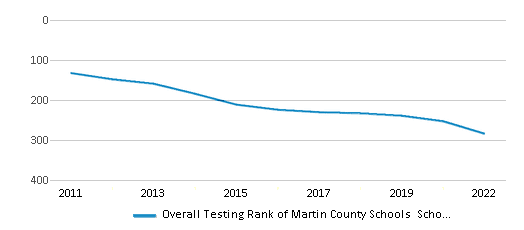
Math Test Scores (% Proficient)
29%
51%

Reading/Language Arts Test Scores (% Proficient)
32%
50%

Science Test Scores (% Proficient)
37%
63%
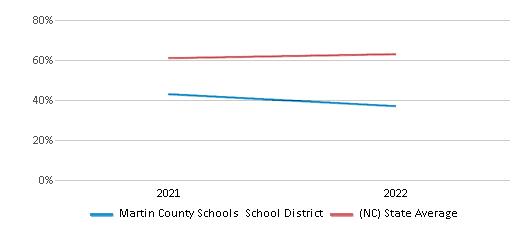
Graduation Rate
75%
86%
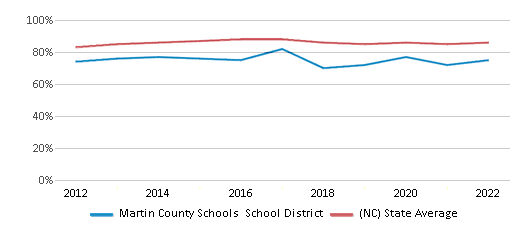
Students by Ethnicity:
Diversity Score
0.63
0.71
# American Indian Students
1 Student
5,633 Students
% American Indian Students
n/a
1%
# Asian Students
18 Students
19,933 Students
% Asian Students
1%
4%
# Hispanic Students
270 Students
98,873 Students
% Hispanic Students
10%
20%
# Black Students
1,355 Students
122,407 Students
% Black Students
52%
25%
# White Students
816 Students
215,701 Students
% White Students
31%
44%
# Hawaiian Students
5 Students
646 Students
% Hawaiian Students
n/a
n/a
# Two or more races Students
149 Students
30,848 Students
% of Two or more races Students
6%
6%
Students by Grade:
# Students in PK Grade:
104
1,882
# Students in K Grade:
219
16,660
# Students in 1st Grade:
228
16,806
# Students in 2nd Grade:
204
17,050
# Students in 3rd Grade:
224
16,530
# Students in 4th Grade:
198
16,849
# Students in 5th Grade:
199
19,618
# Students in 6th Grade:
145
111,560
# Students in 7th Grade:
161
116,793
# Students in 8th Grade:
197
119,029
# Students in 9th Grade:
255
12,380
# Students in 10th Grade:
177
10,877
# Students in 11th Grade:
185
9,420
# Students in 12th Grade:
118
8,569
# Ungraded Students:
-
-
District Revenue and Spending
The revenue/student of $16,821 is higher than the state median of $11,187. The school district revenue/student has stayed relatively flat over four school years.
The school district's spending/student of $15,954 is higher than the state median of $11,612. The school district spending/student has stayed relatively flat over four school years.
Total Revenue
$44 MM
$17,307 MM
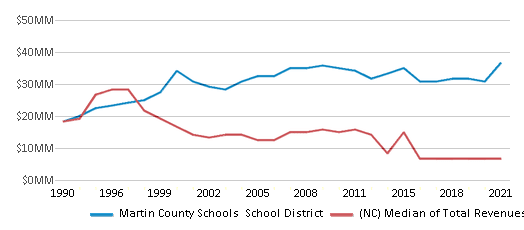
Spending
$42 MM
$17,964 MM
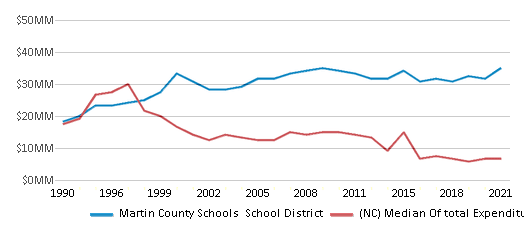
Revenue / Student
$16,821
$11,187
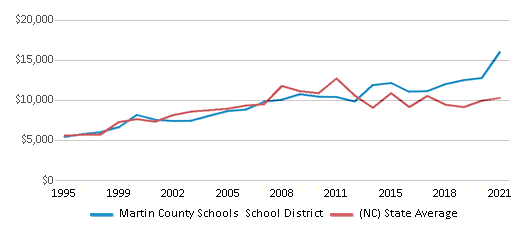
Spending / Student
$15,954
$11,612
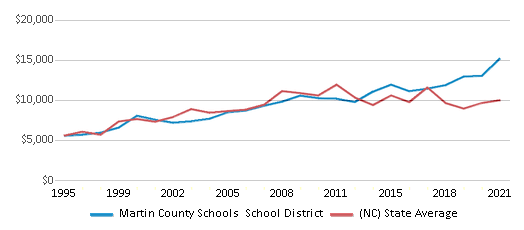
Best Martin County Schools School District Public Middle Schools (2025)
School
(Math and Reading Proficiency)
(Math and Reading Proficiency)
Location
Grades
Students
Rank: #11.
Riverside Middle School
(Math: 24% | Reading: 32%)
Rank:
Rank:
2/
Bottom 50%10
2920 Us Hwy 17
Williamston, NC 27892
(252) 792-1111
Williamston, NC 27892
(252) 792-1111
Grades: 6-8
| 340 students
Rank: #22.
South Creek Middle School
(Math: 10% | Reading: 19%)
Rank:
Rank:
1/
Bottom 50%10
21077 Nc Hwy 903
Robersonville, NC 27871
(252) 792-1575
Robersonville, NC 27871
(252) 792-1575
Grades: 6-8
| 163 students
Recent Articles

Year-Round Or Traditional Schedule?
Which is more appropriate for your child? A year-round attendance schedule or traditional schedule? We look at the pros and cons.

Why You Should Encourage Your Child to Join a Sports Team
Participating in team sports has a great many benefits for children, there is no doubt. In this article you will learn what those benefits are.

White Students are Now the Minority in U.S. Public Schools
Increasing birth rates among immigrant families from Asia and Central and South America, combined with lower birth rates among white families, means that for the first time in history, public school students in the United States are majority-minority. This shift in demographics poses difficulties for schools as they work to accommodate children of varying language abilities and socio-economic backgrounds.





